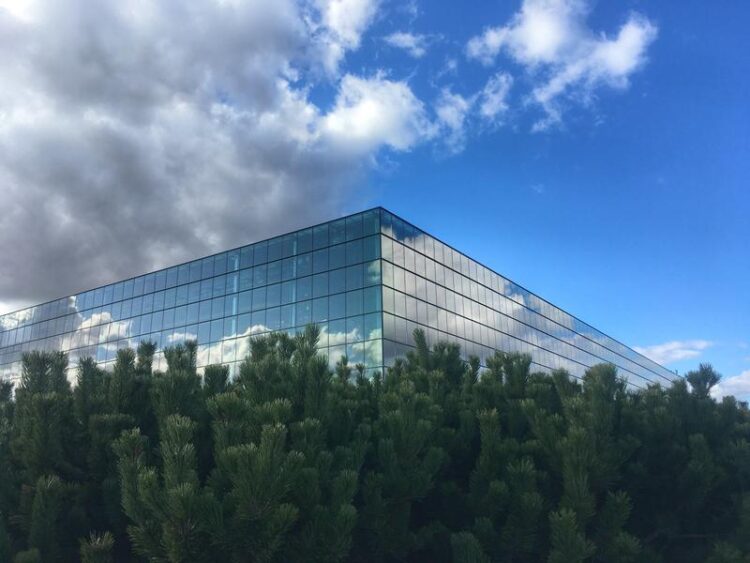Switch2Save: Energy saving potential for buildings

Building with extensive glass façade
Finn Hoyer / © Fraunhofer FEP
In October 2019, the EU-funded initiative “Switch2Save” (grant agreement No. 869929) was launched to improve the availability and affordability of electrochromic and thermochromic smart glass technologies. About one year later, the first project results show that the use of these technologies in combination with intelligent switching protocols can reduce the primary energy use of extensively glazed buildings by up to 70%.
Smart Glass Solutions – such as electrochromic (EC) and thermochromic (TC) windows and glass façades – control the radiation energy transfer and can thus drastically reduce the energy demands for heating and air conditioning of large buildings. In addition, they allow superior indoor lighting comfort in contrast to conventional mechanical window blinds.
EC switching relies on materials that change their light transmittance by applying a low electrical voltage, while TC cells are based on materials that change their infrared reflection properties with increasing temperature. The EU-funded initiative Switch2Save aims to combine and mature EC and TC systems to create lightweight energy smart Insulating Glass Units (IGUs) suitable for large windows and glass façades.
A first step in the project was the development of switching protocols for the TC/EC cells to maximize the energy saving potential and to define a switching strategy for the IGUs. These switching protocols allow controlling the state of the IGUs from bright to dark, taking into account a number of building related parameters. The optimal state of the IGUs should ensure visual and thermal comfort as well as energy savings.
To define the optimal switching protocols, the project partners developed a general switching strategy for a virtual office building with three levels of automation: fully automatic, semi-automatic and predefined operation of IGUs. The indicative implementation of the automatic switching strategy in the Switch2Save IGUs in two different climatic zones (Athens and Stockholm) suggests a variable heating-cooling energy saving potential between 10% and 70% in comparison to typical triple glazed windows with internal shadings. This energy saving potential depends not only on the climatic zone but also on the mode of operation, building characteristics and the window-wall-ratio of the respective building.
Project coordinator Dr. John Fahlteich, Fraunhofer FEP, is excited: “The developed models and simulations show that this switching protocol is able to optimize the switching behavior of our new IGUs, leading to the maximum possible reduction of primary energy use, ensuring or even improving visual and thermal comfort. We are pleased to present these results to the public in detail for the first time in our online workshop.”
In the next step, the protocols will be implemented to the two demo buildings of the Switch2Save project, where they will collaborate with the building automation system. Switch2Save will demonstrate the potential in two representative fully-operating buildings – Greece’s second largest hospital in Athens and an office building in Uppsala, Sweden. The Switch2Save consortium will replace 50 windows and 200 m² glass façade area with the new IGUs and will perform a full “before-after” comparison of the energy demand for a one-year cycle in both buildings. The findings will accelerate the widespread implementation of energy smart glass and significantly contribute to the goal of a CO2-neutral building stock in the EU before 2050.
This project has received funding from the European Union’s Horizon 2020 research and innovation programme under grant agreement No. 869929.
Press contact:
Ms. Annett Arnold
Fraunhofer Institute for Organic Electronics, Electron Beam and Plasma Technology FEP
Phone +49 351 2586 333 | presse@fep.fraunhofer.de
Winterbergstraße 28 | 01277 Dresden | Germany | www.fep.fraunhofer.de
Weitere Informationen:
Media Contact
All latest news from the category: Architecture and Construction
Newest articles

High-energy-density aqueous battery based on halogen multi-electron transfer
Traditional non-aqueous lithium-ion batteries have a high energy density, but their safety is compromised due to the flammable organic electrolytes they utilize. Aqueous batteries use water as the solvent for…

First-ever combined heart pump and pig kidney transplant
…gives new hope to patient with terminal illness. Surgeons at NYU Langone Health performed the first-ever combined mechanical heart pump and gene-edited pig kidney transplant surgery in a 54-year-old woman…

Biophysics: Testing how well biomarkers work
LMU researchers have developed a method to determine how reliably target proteins can be labeled using super-resolution fluorescence microscopy. Modern microscopy techniques make it possible to examine the inner workings…





















